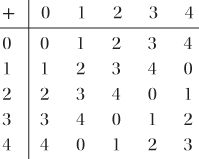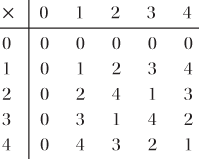The word ‘modulo’ means ‘to the modulus’. For any n ≥ 2, let ℤn be the complete set of residues {0, 1, 2,…, n − 1}. Then addition modulo n on ℤn is defined as follows. For a and b in ℤn, take the usual sum of a and b as integers, and let r be the element of ℤn to which the result is congruent (modulo n); the sum a + b (mod n) is equal to r. Similarly, multiplication modulo n is defined by taking ab (mod n) to be equal to s, where s is the element of ℤn to which the usual product of a and b is congruent (modulo n). For example, addition and multiplication modulo 5 are given by the following tables:

Addition modulo 5

Multiplication modulo 5
When n is prime, as in these tables, then ℤn is a field. Generally ℤn is isomorphic to the quotient ring ℤ/nℤ.